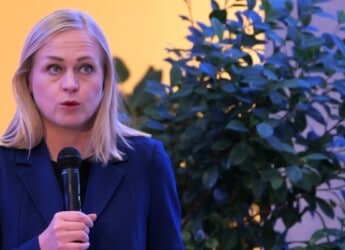|
|
Content Assessment: On the Move? 2022 eDiscovery Market Kinetics: Five Areas of Interest
Information - 93%
Insight - 89%
Relevance - 90%
Objectivity - 92%
Authority - 91%
91%
Excellent
A short percentage-based assessment of the qualitative benefit of the recently published snapshot by ComplexDiscovery of eDiscovery areas of interest that may provide an understanding of market health in 2022.
Editor’s Note: ComplexDiscovery is an online publication that highlights cyber, data, and legal discovery insight and intelligence ranging from original research to aggregated news for use by cybersecurity, information governance, and eDiscovery professionals. The highly targeted publication seeks to increase the collective understanding of readers regarding cyber, data, and legal discovery information and issues and to provide an objective resource for considering trends, technologies, and services related to electronically stored information.
To submit recommendations for consideration and inclusion in ComplexDiscovery’s cyber, data, and legal discovery-centric service, product, or research announcements, contact us today.
Background Note: Regularly ComplexDiscovery is asked to prepare and share both written and verbal (presentation) updates on topics in the eDiscovery ecosystem. Most recently ComplexDiscovery was provided an opportunity to share with the eDiscovery experts of a leading international law firm a concise overview of the state of the eDiscovery market. The presentation consisted of an overview of selected data points from five key areas of interest that may serve as indicators of market health. The presentation also included an opportunity to share additional areas of study that may be useful and interesting for future market opportunities. The presentation and talking points prepared for this educational presentation are provided for your consideration and use.
Talking Points
2022 eDiscovery Market Kinetics: Five Areas of Interest
A Look at Five Areas That May Help Indicate Industry Health
Market Size Background: Mashup Beginning in 2012
- Purpose: Simple and Accessible Source Market Size Information
- Use: Planning for Industry Needs
- Examples: Current Charts for Software and Services
- Current Kinetics: Consistent and Controlled Growth
The annual market size mashup from ComplexDiscovery was initiated in 2012 and originated out of a desire to reconcile published forecasts and data points for market size and industry growth. The mashup is simply an aggregation of published industry data points from research firms, industry commentators, and eDiscovery providers, modeled and presented to highlight market size and growth information. One goal of the mashup exercise was to prepare and share market size and growth information in a format that can be used in planning and presentations by those who may not have the funds to purchase research reports and subscriptions.
The mashup model contains cumulative data points from more than 80 published reports and references to market size and growth since 2012. The mashup has grown from the presentation of basic a single chart sharing software and service information in 2012 to an expanded overview that includes charted information on:
- Combined eDiscovery Software and Services Market
- eDiscovery Software Market
- eDiscovery Services Market
- eDiscovery Market Overview by Geography
- eDiscovery Market Overview by Government/Non-Government Markets
- eDiscovery Market Overview by Task
- eDiscovery Market by Direct Deliverer Approach
Additionally, based on market sizing and segmentation information, eDiscovery software and services providers can get a reasonable idea of how to answer the oft-asked question, “What share of the market do you have?”
Three examples of market size mashup information are provided in the highlighted charts on eDiscovery Market Size by offering, eDiscovery Market Size segmented by collection, processing, and review tasks, and eDiscovery Market Size for the US and rest of the world.
CHART 1 – eDiscovery Market Sizing – Past and Projected
1-eDiscovery-Market-Sizing-Past-and-Projected-2012-2026From this mashup of market size over time, one can consider that:
- The market has grown from $4.73B in 2012 to $13.10B in 2021. It is also expected to continue along a strong growth path, reaching $18.89B in 2026.
- After experiencing a market retraction due to the worldwide pandemic from $11.23B eDiscovery software and services spending in 2019 to $10.89B in 2020, a spending resurgence occurred in 2021. This resurgence resulted in estimated spending for worldwide eDiscovery software and services of approximately $13.1B for 2021.
- Combined eDiscovery software and services market spending is estimated at roughly $13.1B in 2021 and estimated to grow at a CAGR of approximately 7.60% to $18.89B in 2026.
- eDiscovery software market spending is estimated at roughly $4.32B in 2021 (33% of the total market) and estimated to grow at a CAGR of approximately 10.7% to $7.18B in 2026 (38% of the total market).
- eDiscovery services market spending is estimated at roughly $8.78B in 2021 (67% of the total market) and estimated to grow at a CAGR of approximately 5.93% to $11.71B (62% of the total market) in 2026.
CHART 2 – eDiscovery Market Sizing – Overview by Task
2-eDiscovery-Market-By-Task-2021-2026From this mashup of market size by task over time, one can consider the following estimations that may be helpful in planning.
- Spending on review-related software and services is estimated to constitute approximately 67% of worldwide eDiscovery software and services spending in 2021, decreasing to around 62% by 2026. While the percentage of spend is decreasing over time, the actual dollar spend is estimated to increase based on overall software and services market growth, growing from $8.78B in 2021 to $11.71B by 2026.
- Spending on processing-related software and services is estimated to constitute approximately 19% ($2.49B) of worldwide eDiscovery software and services spending in 2021, with that number remaining steady at 19% ($3.59B) through 2026
- Spending on collection-related software and services is estimated to constitute approximately 14% ($1.83B) of worldwide eDiscovery software and services spending in 2021, increasing to about 19% ($3.59B) in 2026.
CHART 3 – eDiscovery Market Sizing – Overview by Geography
3-eDiscovery-Market-Geographical-Overview-2021-2026From this mashup of market size by geography, one can see the projected growth of the US market relative to the rest of the world. In 2021, the US accounted for 64% of worldwide eDiscovery spending, at $8.38B. While global spending is expected to grow to $18.89B in 2026, the share of US spending is expected to decrease to 58% by 2026 and constitute $10.96B of global expenditures.
As can be seen from these charts, the industry’s overall growth continues to be consistent, controlled, and conservative. This growth presents a solid opportunity for investors and a consistent and robust growth rate for those creating or consuming eDiscovery offerings.
Any market forecast risks imperfect projections based on incomplete information and market kinetics. Still, the Market Size Mashup may be helpful as one of the many data points you consider as you seek to understand market size and growth.
Source: eDiscovery Market Sizing Mashups
Mergers, Acquisitions, and Investments – General Tracking with Input Back to 2001
- Purpose: General Database of Industry Investment Activities
- Use: Understanding Investment Patterns and Considering Past Investments
- Examples: Current Charts for Annual and Monthly Events
- Current Kinetics: Strong Activity (Success Driven Consolidation + International Opportunities + Technology-Enabled Expansion) – (Tied to Market Size Growth)
The aggregated listing of eDiscovery-centric mergers maintained by ComplexDiscovery was developed to help track and understand investments and investment patterns related to the companies involved in the delivery of eDiscovery software and services to individuals and organizations in the data and legal discovery ecosystem.
Modeled after updates and shortlists of investment information from industry commentators, the current database was published first on ComplexDiscovery.com in the 2010 time frame and currently highlights nearly 517 investment events beginning in November of 2001 through today. Based on publicly highlighted investment information that has been researched by or provided to ComplexDiscovery, the listing is not perfect in its completeness. Yet, it is complete enough to help to identify investments and investment patterns.
Information shared in the database listing includes the date of the event, parties involved, and the amount of the event, if known.
As one of the goals of the database is to help identify investment patterns, three examples of how the database helps in this area can be seen by the ongoing tracking of investments by year and by month.
CHART 4 – Annual Merger, Acquisition, and Investment Tracking
4-Merger-Acquisition-or-Investment-Events-vs.-Year-Q122- Since beginning tracking in 2001, approximately 517 M+A&I have been recorded by ComplexDiscovery.
- The strongest year for M&A+I activity was 2021 when at least 54 events occurred.
- The total number of events for 2021 was 18 more than the number of events in 2020 (36) and five more than the number of events in 2012, the previous high-water mark year of investment when at least 49 events were reported.
CHART 5 – Merger, Acquisition, or Investments vs. Month
5-Merger-Acquisition-or-Investment-Events-vs.-Month-Q122- From a monthly perspective over time, January appears to be the most active month for M&A+I activity, followed next by June.
- February appears to be the least active month, followed by April.
CHART 6 – Merger, Acquisition, or Investments vs. Month in 2022
6-2022-Merger-Acquisition-or-Investment-Events-vs.-Month-Q1- During the first quarter of 2022, there have been only seven merger, acquisition, or investment events in eDiscovery, the lowest activity of any first quarter since 2017.
Drivers fueling investment in eDiscovery, based on observations of the market and conversations with commentators and value creators, include:
- Consolidation: Driven by a combination of investor pressure for continued accelerated revenue growth, the increasing availability of distressed assets, and the growing number of legal technology and eDiscovery investors.
- Innovation: Driven by the accelerating acceptance and mainstream use of emerging technologies (e.g., artificial intelligence) and the increasing maturity of advanced technologies (e.g., machine learning) in addressing audit, investigation, and litigation requirements.
- Internationalization: Investments driven by providers and their investors seeking access to new and underserved geographical eDiscovery markets and those heretofore untapped potential revenue streams.
- Expansion: Driven by eDiscovery technologies, techniques, and talent being applied in areas outside of the traditional legal discovery continuum supporting cybersecurity and information governance-related activities and requirements.
Simply stated, the motivation is there for investments, the market is there for investments, and the money is there for investments.
Source: eDiscovery Investment Resources
Business Confidence Surveys: Quarterly Surveys Beginning in Early 2016
- Purpose; Understand the Subjective Confidence of eDiscovery Ecosystem Professionals
- Use: Understanding Current and Projected Performance and Current Challenges
- Example: Current and Aggregate Chart for Top Business Challenges
- Current Kinetics: Strong Confidence from Climate, Revenue, and Profit Expectation Perspective (Tied to Market Size Growth and Investments)
The quarterly eDiscovery business confidence survey from ComplexDiscovery was developed to help provide a systematic and consistent mechanism to harvest and report on the personal business confidence levels of individuals working in the eDiscovery ecosystem.
Modeled after out-of-industry business survey examples, the eDiscovery Business Confidence Survey consists of nine core multiple-choice questions designed to gauge confidence around the business climate, revenue, profits, and challenges. Additionally, there are three optional questions related to the business operational issues of Days Sales Outstanding, Monthly Recurring Revenue, and Customer Revenue Distribution.
Initiated in February of 2016, the survey has been conducted for twenty-six consecutive quarters with the latest survey just being completed in late March 2022. Since its inception, more than 2,700 individual responses have been received from legal, business, and technology professionals in the eDiscovery arena, and the latest survey in the spring of 2022 has 52 respondents.
One of the primary goals of the business confidence survey is to arm eDiscovery creators, consumers, and commentators with normalized information that may help them better understand economic trajectories and marketplace challenges that may impact their business.
CHART 7 – Business Climate – Recent Quarterly Results
7-Current-Business-Climate-Overview-Spring-2022- In the spring of 2022, 94.3% of eDiscovery Business Confidence Survey respondents felt the current business conditions are good or normal. This combined confidence level represents a 2.0% decrease in these same feelings when compared to the winter of 2022, when 96.3% felt the conditions were good or normal.
- Exactly 71.2% of survey respondents characterized the current business climate as good. This represents an increase from 63.0% of respondents who viewed the business climate as good in the winter of 2022.
CHART 8 – Business Climate – Cumulative Results
8-General-Climate-Overview-Aggregate-Spring-2022- Through the lens of all twenty-six quarterly surveys administered to date, one can see that the 71.2% of survey responders reporting the general business climate as good is the highest percentage of responders noting the climate as good since the survey’s inception.
- The lowest percentage of respondents reporting the business climate confidence as good was the spring of 2020, at the start of COVID-19 pandemic, when only 27.3% of respondents viewed the climate as good.
CHART 9 – Issues Impacting Business Performace – Recent Quarterly Results
9-Issues-Impacting-eDiscovery-Business-Performance-Spring-2022- In the spring of 2022, 36.5% of respondents viewed increasing types of data as potentially having the most significant impact on their business in the next six months.
- The lowest percentage assigned to an issue impacting business performance was the 5.8% assigned to the budgetary constraints.
CHART 10 – Issues Impacting Business Performace – Cumulative Results
10-Issues-Impacting-eDiscovery-Business-Performance-Aggregate-Spring-2022Additionally, when we look at issue-reporting for all twenty-six surveys, we can see trend information for all issues.
- Notably, we can see that for 14 of the 26 surveys that budgetary constraints have been the biggest issue for survey responders.
- We can also see that lack of personnel, has only been rated as the top issue twice since the inception of the survey, in the winter of 2022 and in the fall of 2021, the quarters preceding the most recent survey.
While the non-scientific results of these subjective surveys are not comprehensive, they may provide you with data points that, when used with other information and your industry expertise, may help you plan, project, and present on the business of eDiscovery.
Source: eDiscovery Business Confidence Surveys
Cost of Discovery – Semi-Annual Survey – Beginning in 2018
- Purpose: Present Baseline Information on Price Bands for a Market Basket of eDiscovery Offerings
- Use: Competitive Understanding of Industry Pricing for Use in Establishing and Adjusting Pricing
- Example: Examples of Review Pricing with Per GB and Per Doc Models
- Current Kinetics: Commoditization Compression (Lower Average Costs) and Premium Pricing Opportunities (Value Driven Price Premiums)
The semi-annual eDiscovery pricing survey from ComplexDiscovery was designed to provide general insight into eDiscovery pricing as shared by individuals working in the eDiscovery ecosystem. The survey was developed out of a desire to understand acceptable pricing bands for twelve specific offerings across three core areas of eDiscovery. Those areas are collections, processing, and review. It was modeled after the business confidence survey in that it was not designed to boil the ocean and to comprehend all pricing models and metrics but was developed to provide a basic understanding of price ranges so providers and purchasers could establish pricing and purchase offerings with some additional objective data points to inform their decisions. Initiated in December 2018, the survey has been conducted seven times, with the latest survey being completed in December of 2021.
Five examples of survey information harvested from participating industry professionals include the per hour cost for a collection by a forensic examiner, the per hour cost for analysis and expert witness testimony from a forensic examiner, the per GB cost to process ESI based on volume at ingestion, the per hour cost for document review attorneys, and the breakout of survey respondents by primary segment.
CHART 11 – Per Hour Cost for a Collection by a Forensic Examiner
11-Collection-Pricing-Per-Hour-Cost-for-a-Collection-by-a-Forensic-Examiner-AggregateThis chart highlights data harvested on the question pricing per hour for a collection by a forensic examiner. As with most questions in the survey, there are approximately four answers available, three answers with price band information and one for the account for respondents who may not have an answer. In the most recent survey, the sweet spot for this offering is between $250 and $350 per hour. The data for the most recent survey also notes that approximately 5% of respondents are open to paying more than $350 per hour for this service. This information is useful for both providers setting prices and purchasers procuring services.
CHART 12 – Per Hour Cost for Analysis and Expert Witness Support from a Forensic Examiner
12-Collection-Pricing-Per-Hour-Cost-for-Analysis-and-Expert-Witness-Support-from-a-Forensic-Examiner-AggregateThe per hour cost for analysis and witness support from a forensic examiner has routinely been between $350 and $550 per hour since the inception of the pricing survey. Additionally, in the most recent pricing survey, more than 11% of respondents highlighted the cost of this task as greater than $550 per hour.
CHART 13 – Per GB Cost to Process ESI Based on Volume at Ingestion
13-Processing-Pricing-Per-GB-Cost-to-Process-ESI-Based-on-Volume-at-Ingestion-AggregateAdditionally, with this chart on processing, one can see that almost one-third of respondents believe the per GB pricing to process ESI at ingestion is under $25. This may be important if you are purchasing services and want to ensure you are getting the lowest price possible for what you might consider a commoditized offering. Also, suppose you are pricing processing as a provider and have a process, integration, or support that commands a premium. In that case, you have survey data that reveals that at least 6% of responders believe pricing for this service to be higher than $75. A data point that may help if you want to set pricing at the upper end of the pricing continuum for this service. Since introducing alternative models as one of the answers to this survey question, between 17% and 22% of survey respondents have reported using alternative pricing models to traditional pricing per GB approaches.
CHART 14 – Per Hour Cost for Document Review Attorneys
14-Review-Pricing-Per-Hour-Cost-for-Document-Review-Attorneys-to-Review-Documents-AggregateIn reviewing the most recent survey results on the question of per hour cost for document review attorneys to review documents, response data highlights that the hourly cost for this task, as viewed by one-third of survey respondents, is less than $40. Also of note is that almost 50% of respondents reported the cost of this task as greater than $40 per hour.
CHART 15 – Respondents By Organizational Segment
15 - Survey Respondents by Organizational Segment-AggregateLast but not least, this final chart provides and graphical breakout of survey responders by organizational segment. The data shows that most of the 581 survey respondents over seven semi-annual surveys have self-identified as being with software/service providers or law firms. During the most recent survey, 42.9% of respondents were with software/services providers, and 39.7% were with law firms. This information is especially relevant if you wonder about respondent perspectives in the areas of pricing.
While there are many potential references in eDiscovery pricing, your experience is the number one source. Hopefully, this information helps you by providing additional data points for consideration and data points to help you make the best decision for your specific needs.
Source: eDiscovery Pricing Surveys
Hart-Scott-Rodino Act Transaction Velocity – Beginning in Fiscal Year 2000
- Purpose: Present FTC and DOJ Reporting on Annual HSR Act Transaction Numbers and Corresponding Second Request Percentages
- Use: Understand Velocity of HSR Transactions and Second Request Attach Rates
- Examples: Annual Combined FTC and DOJ HSR Act Transaction Numbers and Second Request Percentages
- Current Kinetics: Post-COVID Record Rebound and Strong Initial Performance in 2022
CHART 16 – HSR Act Merger Transactions Reported (2000-2022)
16-HSR Act Merger Transactions ReportedTracking reported HSR Act merger transaction information since 2000 as highlighted in a combination of annual reports and recent monthly reporting; one can consider and compare fiscal year reporting.
- New amendments in 2000 to the Hart-Scott-Rodino Act regarding the filing thresholds may explain the marked decrease from 2000 to 2001 in reported HSR Act transactions.
- FY 2021 resulted in the highest number of reported HSR Act transactions since 2000, with 3,644 transactions reported.
- Through two quarters of FY 2022, reporting is on track for another strong year.
CHART 17 – HSR Act Second Request Annual Percentages (2000-2020)
17-Percentage of Transactions Resulting in HSR Act Second RequestsThe percentage of Second Requests annually based on HSR Act transactions has ranged from 2.1% of annual transactions in 2000 to 4.5% in 2009. Most recently, 3.0% has been the attach rate for Second Requests to transactions. The attach rate is essential to understand the potential market universe of Second Request opportunities for law firms and legal service providers.
CHART 18 – HSR Act Second Request Annual Reporting (2000-2020)
18-Number of HSR Act Second Requests - AggregateActual Second Requests have ranged from 98 before the increase in filing thresholds in HSR Act Transactions (2000) to 48 in the 2020 annual report.
The percentage and the actual number of Second Requests may help estimate the future velocity of Second Requests and evaluate legal service provider claims for Second Request experience.
CHART 19 – 2022 HSR Act Merger Transactions (Monthly Reporting)
19-HSR Act Merger Transactions Reported - 2022From an FY 2022 perspective, there currently have been 1,771 HSR Act Transactions reported. A monthly overview highlights the high number of transactions in November 2021 and the slowing transaction rate in January and February 2022.
The transaction information and the previously presented charts may be helpful for law firms, legal departments, and legal services providers seeking to understand the annual and near real-time pulse rate of Hart-Scott-Rodino Act mandated merger transaction reviews and the corresponding opportunities for Second Requests.
Source: HSR Act Reporting Information
Lagniappe – Interesting Areas for Intentional Study
- Digital Embassies
- Estonia and the X-Road
- eResidency and Digital Nomads
- Cyber Law and NATO
Data Embassies
Data embassies are an innovative approach to the digital continuity of nation-states as they serve as extensions of a nation-state’s cloud through state-owned server resources outside of the nation-state’s physical territorial boundaries. The data embassy approach is unique as nation-states historically have stored their information within their physical territorial boundaries. Learn more.
Estonia and the X-Road
The 2007 cyberattacks against Estonia were a turning point for when cybersecurity began to be accepted as an essential part of national security. The incident, a response to the relocation of a Soviet War bronze soldier statue, crippled the websites of banks, government agencies, and media outlets for weeks. Today, the country is on its third National Cybersecurity Strategy (2019–22)—previous strategies ran from 2008 to 13 and 2014 to 17. Estonia’s current strategy highlights its innovator role at the vanguard of novel cyber approaches. The tiny European nation has come a long way after crippling cyberattacks in 2007. Now it offers key lessons in attracting tech talent and educating citizens. Learn more.
eResidency and Digital Nomads
In 2014, Estonians asked: If their country could serve citizens and residents entirely online, why not open up their digital borders to more people? This new population wouldn’t need citizenship or physical residency, but would still be issued an Estonian digital ID card, enabling them to operate within Estonia’s digital business environment without physically being in the country. This would allow more people to establish and manage an E.U. company entirely online, helping democratize entrepreneurship globally. Learn more.
Cyber Law and NATO
The Cyber Law Toolkit is an established go-to resource for professionals and scholars working on international law and cyber operations. The Toolkit is updated in an ongoing manner, with the current iteration representing the 2021/2022 update. The Toolkit‘s core assets are hypothetical scenarios, each of which contains a description of realistic cyber incidents inspired by real-world examples and accompanied by detailed legal analysis written in an accessible language. Learn more.
Source: ComplexDiscovery

0 - Market Kinetics - eDiscovery - 042522 - Update

























